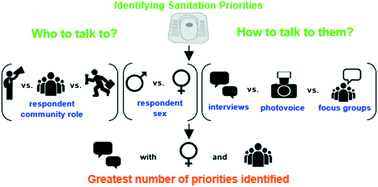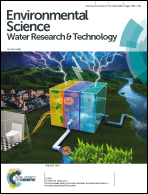A comparison of interviews, focus groups, and photovoice to identify sanitation priorities and increase success of community-based sanitation systems†
Abstract
Addressing priorities is essential for the success of water and sanitation projects, especially in resource-limited communities. In order to quickly assess a resource-limited community's priorities and sanitation needs, sanitation implementers often rely on a single method for priority assessment without understanding its effectiveness, such as its ability to identify the greatest number of unique and most important priorities. To increase the sector's exposure to and understanding of more comprehensive and qualitative priority identification methods, this paper compares three qualitative priority identification methods: interviews, focus groups, and photovoice. Each method was used to identify community priorities (e.g., jobs, electricity) and sanitation priorities (e.g., cost, cleanliness) in twenty communities in India. A cross-case comparison of the three methods for both community and sanitation priorities found that interviews identified the greatest number of unique priorities and most important priorities. Since many respondent attributes are expected to impact a method's effectiveness, the impact of each respondent's sex and community role (leader, member, sanitation system manager) was also evaluated. Regardless of method, community members voiced more priorities, including more of the most important priorities, than community leaders or sanitation system managers. Leaders and system managers, as well as males and females, identified similar numbers of unique and most important priorities. These results are in contrast with current practice and support the use of interviews and the inclusion of community members during priority identification efforts. Environmental engineers, researchers, government agencies, and sanitation implementers can use these results to better identify priorities, which, if addressed, can increase community acceptance and ultimately minimize project failure.

- This article is part of the themed collection: Sanitation


 Please wait while we load your content...
Please wait while we load your content...